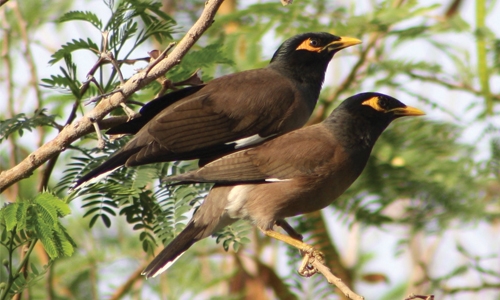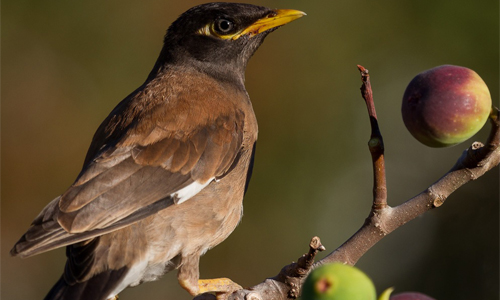Invasive behaviour of Myna under study
Manama : A PhD student at the Department of Environmental Sciences and Natural Resources at the College of Graduate Studies at Arabian Gulf University (AGU) is studying the behaviour of Myna birds seen common in Bahrain and GCC countries, and its impacts on biodiversity in the Kingdom. The study is within the framework of his PhD thesis entitled, “ Environment of Invasive Species and Risk Analysis of Exotic Birds in Bahrain: A Case Study on the Common Myna”.
Head of the Department of Environmental Sciences and Natural Resources at the College of Graduate Studies, Dr Mohammed Suleiman Obaido, said that this research coincides with Bahrain’s biodiversity strategy and the Kingdom’s commitment to the Strategic Objectives of the Convention on Biological Diversity, known as the Aichi 2020 targets, regarding the reduction of direct pressures on biodiversity and advancing sustainable use, with respect to the ninth clause stating, “By 2020, invasive alien species and their pathways are to be identified and prioritised, and priority species are to be monitored or eliminated, and measures are placed to manage their pathways to prevent their introduction and propagation”.
Researcher Nasser Baqer Assadullah said, in the context of rapid progress in the sectors of transport and international trade, and amid population growth and rapid urbanization, ecosystems have become subjected to pressures that have led to the disruption of their stable biological diversity. “These pressures have broken biogeographic barriers that determine the types of species of living organisms that inhabit their natural environments,” he explained.
“Multiple transportation means have contributed to transporting many birds from their natural environments to new ones in cities with environmental factors that are completely different from their original natural environments. Due to many cases of some birds escaping from markets of sale, some of them were able to settle in new environments and to propagate noticeably, resulting in these exotic birds crowding local birds and occupying parts of their environments and sometimes the whole environment,” he further said.
“The negative effects caused by these alien birds is their transformation into invasive birds that cause economic or environmental damage. The Myna bird is the world’s first invasive bird and is in second place on the list of the top 100 most pervasive invasive species on the face of the Earth, according to the International Union for the Conservation of Nature and the Invasive Species Specialist Group,” he stressed.
The areas of research are to identify exotic birds in Bahrain, to create a system to manage invasive birds, and to assess the invasive potential of the common Myna bird in invading the environments of other birds in Bahrain, to detect the effects of the bird on local and exotic birds in the urban, agricultural and natural systems, and to predict the fate of birds in the future. In addition to the introduction of a risk analysis system for Myna birds that could be adopted to analyze the risk of introducing other birds.
The research attempts to answer a number of questions pertaining to the number of exotic bird types in Bahrain. How many of these birds are considered invasive? Is the Myna bird itself invasive, and what are the factors that make it an invasive bird? In addition to how the trafficking of birds has helped to propagate them intensively under captivity. The study is conducted through field surveys of bird markets in the Kingdom of Bahrain and another investigation on the hobby of breeding exotic birds, to identify the most important birds circulating in the Kingdom and to identify the birds most able to consolidate self-sufficient groups.
The researcher Assadullah has raised a group of Myna birds in captivity in Al Areen Wildlife Park in order to find out the details of the bird’s behaviour, to facilitate the field observation in the ecosystems throughout the Kingdom, to discover the areas of the bird’s presence through geographic information systems. Surveillance under captivity is carried out through surveillance cameras, which monitor the behavior of the bird over a 24-hour period, connected to a computer and a monitoring screen.
Related Posts



